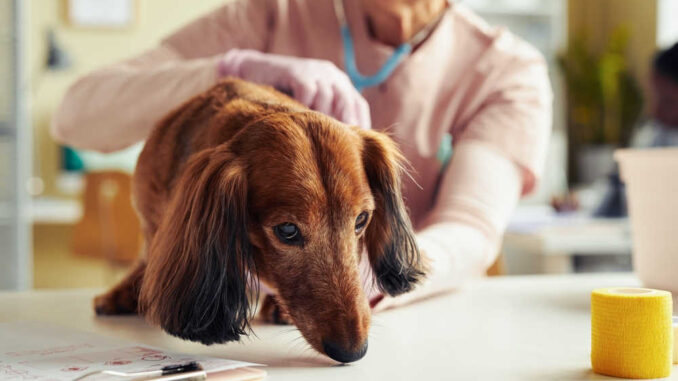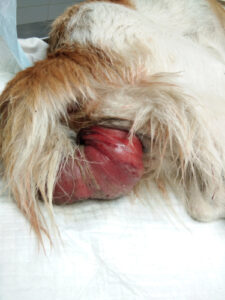
This article was updated on April 7th, 2023
When I had a call from a panicked owner about a pink mass bulging from her dog’s hind end, I suspected a prolapse. So, I advised my client to bring her pooch in for an exam and treatment.
There are three different ways a dog can prolapse. In this article, we’ll examine the conditions, what you can do to help your dog, and when it’s time to go to the vet.
Prolapses in dogs
When a dog prolapses tissue through the rectum or anus, you may see
- A blob of pink protruding tissue
- Your dog hunching over and straining
- Licking at the anal or vaginal areas
- Pain and difficulty urinating or defecating
Rectal prolapse
Example picture – In rectal prolapse, the rectum bulges out through the anal opening. The condition may be partial or complete. With a partial prolapse, only the inner lining of the rectum pushes out through the anus. When there’s a complete prolapse, all layers of the rectum will protrude out through the anal opening.
Common signs of rectal prolapse include:
- Scooting
- Bleeding from the hind end
- Straining to defecate
- Changes in the poop
- Fecal incontinence
A rectal prolapse requires veterinary care.
Urethral prolapse
Example picture – While urethral prolapse can occur in males or females, you’re more likely to notice one in a male dog. The condition occurs when a small portion of the urethral lining slips out through the vagina or penis.
Signs include
- A pea-sized purple or reddish mass
- Excessively licking the genital area
- Straining to urinate
- Pain
Treatment for urethral prolapse varies depending on the severity and symptoms of the condition in your dog.
Vaginal prolapse
Example picture – If the bulge of pink tissue is coming out of your dog’s vulva, it could be a vaginal prolapse. This condition is most common in intact females just before or during a heat because an estrogen surge causes the tissue of the vaginal wall to swell and bulge out of the vulva.
Signs of vaginal prolapse include:
- Excessive licking of the vulva
- Difficult urination/straining to urinate
- Resistance to mating
- A pink or red mass bulging from the vulva
Unless the prolapse interferes with your bitch’s ability to urinate, it may not require veterinary care. Read our veterinarian FAQ: “Dog Vaginal Prolapse: FAQ With Our Veterinarian Dr. Liz Guise“
Uterine prolapse

Fortunately, uterine prolapse is rare in dogs. The condition usually occurs when part of the uterus pushes through the cervical opening during a spontaneous abortion or immediately after whelping (see other image here).
Signs of uterine prolapse include:
- Abdominal pain
- Restlessness
- Continued and abnormal straining after delivery
- Excessive licking around the vulva
- Excessive bleeding
- Bulge of dark pink or red tissue from the vulvar area
The presence of a uterine prolapse requires immediate veterinary care.
Is a dog prolapse an emergency?
Whether your dog’s condition is an emergency depends on the type of prolapse.
- Complete rectal prolapses require prompt veterinary treatment to avoid infections or damage to the rectal tissues. If you can’t get your dog to the clinic immediately, you should keep the bulging tissue moist and protected until your veterinary appointment.
- Vaginal prolapses are not usually an emergency unless the bulge interferes with urination. If the prolapse blocks the urethra and prevents your pooch from peeing, hospitalization may be required.
- Uterine prolapses can be life-threatening emergencies. The tissues quickly engorge with blood and can become necrotic. The prolapse may also block the urethral opening so your dog cannot urinate. When dogs move around or lick/chew the prolapse, they can cause the uterine artery to rupture. If you suspect a uterine prolapse, bring your dog to the vet immediately.
Is there anything I can do at home to help my dog?
Unless you’re dealing with a partial rectal prolapse, treatment of these conditions is best handled by a veterinarian. However, if you can’t get to the vet immediately, there are things you can do at home to help your dog recover.
Partial rectal prolapse quick fix (not advised)
If your pooch has a minor bulge of the rectum, some people suggest you may be able to gently wash the tissue, apply some lubricant, and push the prolapse back inside, as demonstrated in this video(notice the person used gloves): https://www.youtube.com/watch?v=qAXUEs-73g4
However, you risk injuring the rectal tissues and this will be a temporary fix at best. Usually, there’s an underlying cause of the prolapse such as intestinal parasites or diarrhea. Your dog may easily push the tissue back out if he continues straining.
This procedure will NOT work if the rectal prolapse is severe or complete because the tissue is usually swollen and friable. You’re more likely to cause a rectal tear or rupture if you try to fix a complete prolapse at home.
How to help your dog at home if he has a rectal prolapse
When you can’t get to the veterinarian immediately, you should prevent your dog from licking his hind end. If you have an e-collar at home, put it on your pooch. Additionally, keep the exposed tissue clean and moist. Gently rinse the area with sterile saline and apply a clean, moist cloth. You may also put a doggie diaper on your pooch to prevent scooting and abrading the prolapse. Then, get your dog to the veterinarian for treatment as soon as possible.
What to do for your dog if he has a urethral prolapse
If you notice a pink or purple bulge of tissue at the tip of your dog’s penis, you should contact your veterinarian to confirm the diagnosis and rule out other conditions such as a tumor or infection. At home, restrict your dog’s activity to allow time for proper healing.
How to help your dog at home if she has a vaginal prolapse
You can usually manage your dog’s vaginal prolapse at home after visiting the veterinarian. The doctor may prescribe hormones and topical cream to help reduce the swelling so the prolapse can resolve. At home, you can
- Gently wash the exposed tissue with sterile saline every day
- Apply lubricating jellies or creams
- Use a doggie diaper or padding to protect the prolapse from abrasion
- Put an e-collar on your dog to discourage licking or chewing at the area
What to do if your dog has a uterine prolapse
If your dog has a uterine prolapse, call your vet or the emergency clinic and take your dog in immediately. On the way, keep your dog calm and as still as possible to prevent irritation or tissue damage. Keep the prolapsed tissue moist and lubricated with sterile KY jelly or another sterile lubricant.
When at-home treatment is not recommended
When it comes to rectal and vaginal prolapses, you may be able to treat your pooch at home. However, you should bring your dog in for veterinary care under the following circumstances.
- Your dog is not able to urinate or defecate
- There are signs of tissue damage
- The tissue becomes necrotic and appears blue-black or black
- Your dog continually licks or chews at the prolapse
- Your dog continues straining and risks a repeat occurrence
Veterinarian treatment, costs & recovery
The treatment for prolapse in your dog will depend on the type and severity of the prolapse along with any underlying conditions.
Rectal prolapse
Your veterinarian will conduct an examination including a rectal exam to confirm the diagnosis and rule out other conditions like tumors. He will also take a stool sample, blood tests, x-rays, and other diagnostic tests to identify underlying causes.
To correct the prolapse, your veterinarian will:
- Anesthetize your dog to prevent pain and straining
- Gently clean the tissues with a saline solution
- Apply medication to reduce swelling
- Gently replace the prolapsed tissue
- Apply a purse-string suture to hold the prolapse in place
- In severe prolapses, your veterinarian may need to surgically resect part of the rectum
Follow-up treatment at home may include dietary restrictions, an e-collar, antibiotics, and pain medication to prevent straining. The vet will also treat any underlying cause. With prompt treatment and resolution of the condition, the prognosis is good for dogs. The cost of treatment generally ranges between $300 and 2,500 depending on the severity of the condition.
Urethral prolapse
To diagnose a urethral prolapse, your veterinarian will take a history of your dog’s symptoms and examine his penis. The doctor may also collect urine and blood samples and take x-rays to check for underlying conditions.
Depending on the severity of the symptoms and extent of the prolapse, treatment may include:
- Surgical correction for excessive pain or bleeding
- Castration if prolapses only occur during erections
- Antibiotics to treat or prevent infections
- Reduced physical activity
The prognosis for urethral prolapse is good, but recurrence is likely in intact males. The average cost of treatment is about $750.
Vaginal prolapse
Vaginal prolapses in dogs can usually be diagnosed based on the timing and appearance of the mass. However, your veterinarian will likely take blood, urine, and tissue samples to identify any underlying infections and rule out cancerous growths in older females.
Treatment for vaginal prolapse may include:
- Catheterization if the prolapse is blocking the urethra and preventing urination
- Topical anti-hemorrhoidal creams to reduce swelling
- Hormone therapy to induce ovulation and encourage the prolapse to regress
- Surgical removal of any damaged or necrotic tissue
- Spaying is often recommended to prevent a recurrence
The prognosis for vaginal prolapse is good, but the condition can recur in intact females with subsequent heats. The average cost of treatment is about $850.
Uterine prolapse
Many times, uterine prolapse is easy to diagnose when tissue is protruding from the vagina. However, if the prolapse isn’t visible from the outside, your veterinarian will take blood and urine samples and conduct a vaginoscopy and finger examination to confirm the diagnosis and any underlying conditions.
Dogs require hospitalization to treat uterine prolapse. Your veterinarian will need to anesthetize your pooch. Depending on the severity of the prolapse and whether the tissue is still healthy and viable, treatment may include:
- Cleaning and lubricating the uterus with sterile solutions
- Using local anesthesia to prevent straining
- Providing medications to encourage the uterus to shrink
- Gently replacing the uterus if the tissue is healthy and you intend to breed your dog in the future. The uterus is then held in place by suturing it to the abdominal wall.
- Removing the uterus and ovaries if the tissue is compromised or you don’t intend to breed your dog
- Antibiotics to prevent infection
The prognosis for a dog with a prolapsed uterus is guarded and will depend on how quickly you seek treatment, the severity of symptoms, and whether any complications ensue. The cost of treatment can run $1600-2500 and may involve prolonged follow-up care.
Disclaimer: This website's content is not a substitute for veterinary care. Always consult with your veterinarian for healthcare decisions. Read More.


Be the first to comment